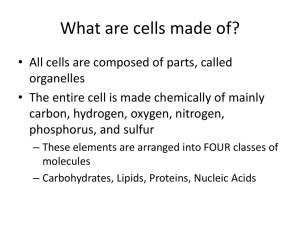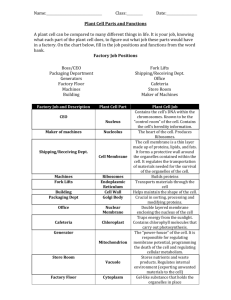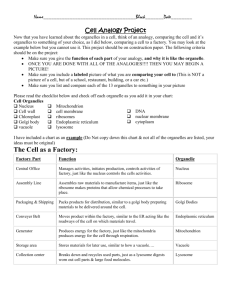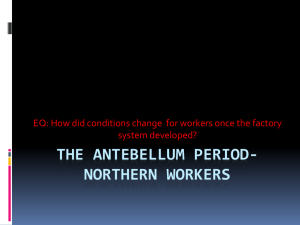3.2 PPT_Organelles - mshollis
advertisement
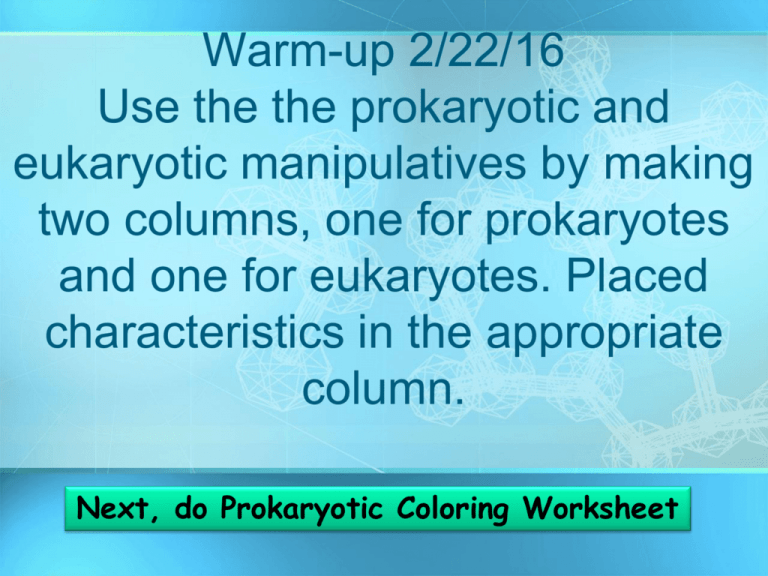
Warm-up 2/22/16 Use the the prokaryotic and eukaryotic manipulatives by making two columns, one for prokaryotes and one for eukaryotes. Placed characteristics in the appropriate column. Next, do Prokaryotic Coloring Worksheet Now we will take a moment to review the Practice Problems and Venn Diagram on your “What Is A Cell?” Notes copyright cmassengale 2 Clear Your Desk. Time for a POP QUIZ!!!!! • Quiz on Prokaryotic vs. Eukaryotic Cells. • Please Omit the last section that says “Justification” • For 5 points Extra Credit 1. Name two scientists and their contribution to our current understanding of the cell AND 2. The 3 parts of the cell theory. 3 • • • • • • • • • • HONORS BIOLOGY EDIBLE CELL PROJECT DUE FRIDAY, MARCH 4 Edible cell or Prezi (Cell city) NON-PERISHABLE ITEMS!!! NO CAKES OR COOKIES. Work with 1 partner Plant AND Animal Cell Label and represent all organelles. Don’t forget to create the cytoplasm. Be creative Use a key to distinguish organelles and include an accurate description of their function. 1 test +quiz grade copyright cmassengale 4 Copy Organelle Guided Notes from class wiki. 10 minutes • • • • Mshollis.cmswiki.wikispaces.net Biology Daily Assignments Today’s Date (2/22/16) 3.2_PPT_Organelles • We will go over these notes before the end of class today! copyright cmassengale 5 Complete Activity 4: What Do Cells Do? (25 minutes) • Due today!!! • Follow instructions on worksheet to complete copyright cmassengale 6 Two Main Types of Eukaryotic Cells Plant Cell Animal Cell Organelles Organelles • Very small (Microscopic) • Perform various functions for a cell • Found in the cytoplasm • May or may not be membranebound Animal Cell Organelles Nucleolus Nucleus Nuclear envelope Rough endoplasmic reticulum Golgi apparatus Ribosome (attached) Ribosome (free) Cell Membrane Mitochondrion Smooth endoplasmic reticulum Centrioles 10 Plant Cell Organelles 11 Cell or Plasma Membrane WHAT it is: • • Controls what enters or leaves the cell Composed of double layer of phosphoLIPIDS and proteins Its FOUND in: • ALL CELLS FACTORY: • • Security Guard Gate around the Factory Outside of cell Proteins Carbohydrate chains Cell membrane Inside of cell Protein channel Lipid bilayer 12 Phospholipids • Tails = HATE water • Heads = LOVE water • Hydrophillic Heads contain Glycerol & Phosphate (WATER LOVING) • Hydrophobic Tails are made of fatty acids (WATER FEARING) • Make up a bilayer where tails point inward toward each other 13 The Cell Membrane is Fluid Molecules in cell membranes are constantly moving and changing copyright cmassengale 14 Cell Wall FUNCTION: • Supports and protects cell • Found outside of the cell membrane • Made of Cellulose FOUND In: • PLANTS ONLY FACTORY: • BRICK WALL protecting to outside of the whole factory 15 CELL WALL Cytoplasm of a Cell FUNCTION: • Watery, jelly like environment that contains all the organelles cytoplasm FOUND IN: • ALL CELLS FACTORY: • The FLOOR of the factory OR • Like the AIR in the factory 17 NUCLEUS FUNTION: • Controls the normal activities of the cell • Contains the DNA in chromosomes FOUND IN: • ALL CELLS FACTORY: • The BOSS of the factory 18 NUCLEUS 19 Inside the Nucleus The genetic material (DNA) is found DNA is spread out And appears as CHROMATIN in non-dividing cells DNA is condensed & wrapped around proteins forming as CHROMOSOMES in dividing cells 20 What Does DNA do? DNA is the hereditary material of the cell Genes that make up the DNA molecule code for different proteins 21 Mitochondria FUNCTION: • “Powerhouse” of the cell • Generate cellular energy (ATP) • Site of CELLULAR RESPIRATION (breaks down glucose to give the cell energy) FOUND IN: • ALL CELLS FACTORY: • POWERPLANT of the factory • The FURNACE burning coal for energy 22 MITOCHONDRIA IMPORTANT: Folded shape increases the surface area for more reactions (= MORE ATP CREATED) 23 MITOCHONDRIA 24 Chloroplasts FUNCTION: • Use energy from sunlight to make own food (glucose) during Photosynthesis • Are green because of CHLOROPHYLL FOUND IN: • PLANTS ONLY! FACTORY: • Solar energy panels • Coal burned by furnace (mitichondria) for energy CHLOROPLAST FUNCTION: Ribosomes • Makes PROTEINS!!! • • • “Protein factories” for cell Join amino acids to make proteins (called protein synthesis) Can be: free or attached (to the ER) FOUND IN: • ALL CELLS FACTORY: • The WORKERS RIBOSOMES 28 Vacuoles FUNCTION: • Storage compartment in cells • Plant cells have a LARGE Central Vacuole • Small or absent in animal cells FOUND IN: • Large vacuole in PLANTS FACTORY: • Storage closet or warehouse VACUOLE Endoplasmic Reticulum - ER FUNTION: • Transport chemicals between cells and within cells • Provides large surface area for chemical reactions to occur • Two Kinds: – Rough = has ribosomes – Smooth = no ribosomes FOUND IN: • ALL CELLS FACTORY: • Assembly line of the factory Endomembrane System Includes nuclear membrane connected to ER connected to cell membrane (transport) copyright cmassengale 32 ENDOPLASMIC RETICULUM 33 Golgi Bodies FUNCTION: • Sort and packages the products of the cell for transport within and out of the cell • Looks like a stack of pancakes! FOUND IN: • ALL CELLS FACTORY: • Postal Office • Mail Room GOLGI APPARATUS 35 Golgi Animation Materials are transported from Rough ER to Golgi to the cell membrane by VESICLES copyright cmassengale 36 Lysosomes • FUNCTION: • Digest and get rid of worn out cell parts and invaders • Do this with ENZYMES! • FOUND IN: • Mostly ANIMALS (some plants) • FACTORY: • Janitors • Wrecking ball Centrioles FUNTION: • Help move chromosomes (DNA) during cell division FOUND IN: • ANIMALS ONLY! FACTORY: • Like CRANES used to moves stuff around the factory 38 Centrioles & the Mitotic Spindle Made of MICROTUBULES (Tubulin) copyright cmassengale 39 CENTRIOLES 40 Cilia & Flagella • FUNCTION: • Moving cells, in moving fluids, or in small particles across the cell surface • FOUND IN: all cells • FACTORY: • The maintenance trucks that drive the workers around the factory Cell Movement with Cilia & Flagella Plant Cells vs. Animal Cells Cell Wall Chloroplasts 1 Large Vacuole No Centrioles Lysosomes are rare Centrioles Lysosomes are common Several Small Vacuoles No Cell Wall No Chloroplasts Practice Guided Practice Independent Practice • Review The Cell as a Factory Homework • Cell City Worksheet copyright cmassengale 44 Cell City Analogy & Project • Complete the Cell City Analogy practice • This is individual • Read the descriptions carefully and pull out which parts of the factory match your organelles • While working, begin thinking about YOUR analogy for you PROJECT!! Cell Analogy Foldable Project. Due Wednesday copyright cmassengale 46 List and Describe two major differences between plant and animal cells? Organelle Matching • With your partner, use your notes and each other to match the organelle with its description and picture • Line up like this… PICTURE ORGANELLE DEFINITION **When done: 1. Call me over to check your work
